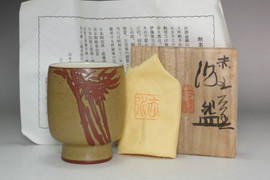Ito Sekisui 5th (1941- ) Vintage MUMYOI pottery teabowl #4994
- SKU:
- 4994
- Shipping:
- Free Shipping
Diameter: approx. 11.5cm (4 17/32in)
Height: approx. 8.7cm (3 27/64in)
weight: 382g (w/ box 604g)
Ito Sekisui 5th
1941-
male
mumyoi pottery
living national treasure
Born in Sado County, Niigata Prefecture. He was born as the eldest son of the fourth generation of Sekisui, whose real name is Yoichi. After graduating from Kyoto Institute of Technology in 1966, he studied Mumyoi ware under his grandfather, the third generation, and was selected for the Japan Traditional Crafts Exhibition in 1972. In 1976, he succeeded to the name of Sekisui V. He continued to research and refine his techniques.
In 1985, he was awarded the Prince Chichibu Cup for the best work at the Japan Ceramic Art Exhibition.
In 1993, to celebrate the wedding of the Crown Princess, Niigata Prefecture donated a “Mumyoi pottery Jar” to the Owada family, the family home of the Crown Princess, as a celebratory gift.
On July 10, 2003, Mumyoi ware, a craft technique, was designated as an Important Intangible Cultural Property, and Ito Sekisui V was recognized as its holder (Living National Treasure). Mumyoi ware uses a technique called “neriage,” in which clay of different colors is layered to make a kind of rolled sushi, and then the cross sections of the rolled sushi are cut into round slices and arranged to form the shape of a plate or pot. The unique striped patterns and floral patterns are characteristic of Ito Sekisui V.
Mumyoi pottery
Mumyoi is a type of red soil which contains a rich amount of iron oxide which is produced from around the Gold Mine, and the Mumyoi pottery uses it as its pottery clay, which is then baked at high temperatures.
The character of the clay is such that it requires special work such as polishing while raw and then polishing it with sand after baking it.
In addition, the pottery clay goes through “elutriation” – a way to get rid of sand and impurities in the process of balancing the clay particles – using a 200-mesh sieve which makes the baked pottery clay shrink by around 30% due to the loss of these particles.
Therefore the product is extremely hard and when hit it makes a clear metallic sound and the more use it gets the more it shines.
The Mumyoi Ware products are gaining attention as a means of improving the taste of tea, alcohol, beer and coffee.
In China, Mumyoi had been used as a type of herbal medicine to cure hemostasis since ancient times, but as they did not know the source of the effect they seemingly named it Mumyoi (no name). In Japan this was gathered only around the Sado Gold Mine. It was a byproduct of mining operations during the 1640s – the height of the gold rush on Sado Island after the discovery of the Aikawa mines.
The history of Mumyoi ware began with Ito Jinpei creating Raku Ware using the Mumyoi produced from the Sado Mines in the 2nd year of Bunsei (1819).
Afterward, Miura Jozan (1836-1903) realized that Mumyoi produced from the Sado Mines has a very similar nature to Yixing clay. He doubled his efforts to change the usual Mumyoi ware, which was quite fragile, into strong pottery similar to the pottery created from the Yixing kiln in China, and he completed a piece of strong, high-temperature Mumyoi pottery. Tea tools in Mumyoi ware became popular among people who like green tea because they made tea delicious like Chinese Yixing ware.
According to a record, the famous shogunate retainer, Katsu Kaishu bought tea tools from Miura Jozan.
In 2003 Mumyoi Ware was registered as a National Important Intangible Cultural Property.
The Agency for Cultural Affairs is attempting to register Sado Aikawa gold mines in the World Heritage List now. Unfortunately, because of this, it became very difficult for potters to obtain Mumyoi from around Sado Aikawa gold mines because collecting the mine soil from the area was banned.

















